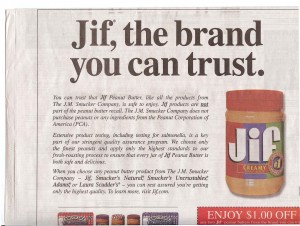Having lived in Brisbane for a year, I can testify to the range of fantastical insects and rodent-like creatures.
Beginning in April 1996, some 500 people across Australia were stricken with Salmonella that made its way into peanut butter.
At first, investigators focused on chicken; that chickens carry Salmonella has been worn into the public’s food safety conscious for decades. But as cases of Salmonella  increased across the country and after questioning the sick and the vomiting, an unlikely food source emerged: peanut butter.
increased across the country and after questioning the sick and the vomiting, an unlikely food source emerged: peanut butter.
In the 1996 Australia outbreak, researchers first found the same genetic strain of Salmonella in peanut butter from the homes of some of the sick (unlike fresh produce, the long shelf-life of peanut butter provides an advantage for disease detectives). Because the manufacturer retained samples for shelf-life tests, the peanut butter was found to contain the same strain of Salmonella, as did the roasted peanuts from a single supplier.
After six months of investigation, Australian researchers came up with a theory: the roasting company had moved and separated the roasted peanuts with an auger, a drill-like machine with a spiraling blade that could lift piles of peanuts, that had been contaminated with mouse feces.
Peter Wood, senior lecturer in microbiology at Queensland, University of Technology, Brisbane, was quoted as telling the American Society of Microbiology in 1999 that, “The auger was only used four times because it proved not to be as time-saving as first thought,” and the machine had been kept in the company tool yard. During that time, eastern Australia was in the throes of a plague of mice. The rodents nested  everywhere, including the tool yard, where their droppings contaminated the auger. When the auger was brought in to the plant, it was washed down but Wood said it was not sanitized before it was used on Jan. 10, 1996. Salmonella from the auger mixed with the peanuts, and contaminated the system.
everywhere, including the tool yard, where their droppings contaminated the auger. When the auger was brought in to the plant, it was washed down but Wood said it was not sanitized before it was used on Jan. 10, 1996. Salmonella from the auger mixed with the peanuts, and contaminated the system.
Salmonella is commonly associated with the feces of birds and animals, has been found to survive in soil in almond orchards, and could be introduced at a multitude of stages in the peanut butter-making process. Although processing normally eliminates contamination, several studies following the 1996 Australian outbreak have revealed that the high fat content of peanut butter can actually protect individual bacteria during the heating process.
Similarly, in 2006, Cadbury in the U.K. recalled 1 million candy bars after tentative links with Salmonella cases stretching over 6 months. A leaky pipe in the production facility may have been the cause. Maintenance and sanitation, two departments integral in food safety system success, appear to have failed in both outbreaks.
Additional outbreaks involving ConAgra (2007) and Peanut Corporation of America (2009) further demonstrated the vulnerability of an invulnerable foodstuff.
Now, 29 persons infected with the outbreak strain of Salmonella Bredeney have been reported to PulseNet from 18 states linked to Trader Joe’s Valencia Creamy Salted Peanut Butter.
The peanut butter was made by Sunland, Inc and manufactured between May 1, 2012 and September 24, 2012.
What’s worse is that at the same time, CBS reports food manufacturers in Georgia may be dodging a first-of-its-kind law requiring that they inform state food inspectors when their products test positive for contamination, according to an audit of the state’s food inspection service.
An audit released this summer offers a combination of anecdotal and statistical evidence suggesting the so-called “red flag law” was not strictly followed after it was implemented in 2010. The state adopted the law after a deadly salmonella outbreak  that killed nine people and sickened hundreds more was traced back to a filthy southwest Georgia peanut producer. The crisis put a big dent in the state’s peanut industry, then valued around $2.5 billion annually.
that killed nine people and sickened hundreds more was traced back to a filthy southwest Georgia peanut producer. The crisis put a big dent in the state’s peanut industry, then valued around $2.5 billion annually.
Guess they never heard of that in New Mexico, where Sunland is based, and brags about a bunch of audits resulting in a big thumbs up.
Anyone can talk a good food safety game; and since most food safety is faith-based, the pronouncements from on high are treated with reverence by the consuming public.
But the data just isn’t there.
And if it is, companies and growers need to start making it public until this whole food safety thing goes off into some sort of golden plates religion.
Keep the faith.
